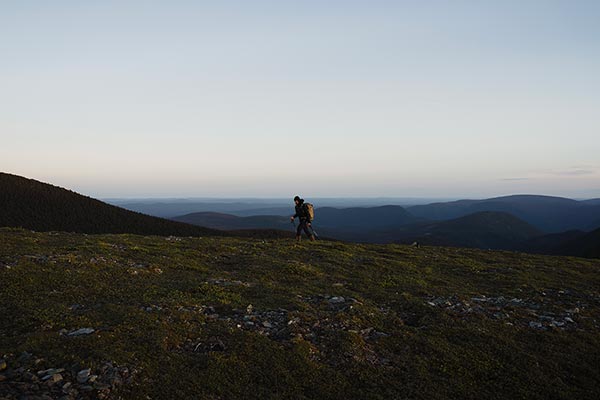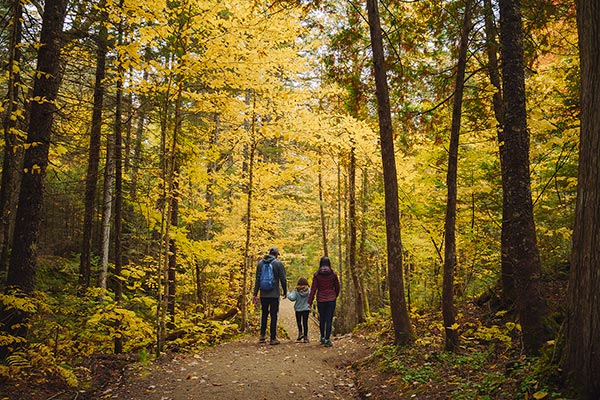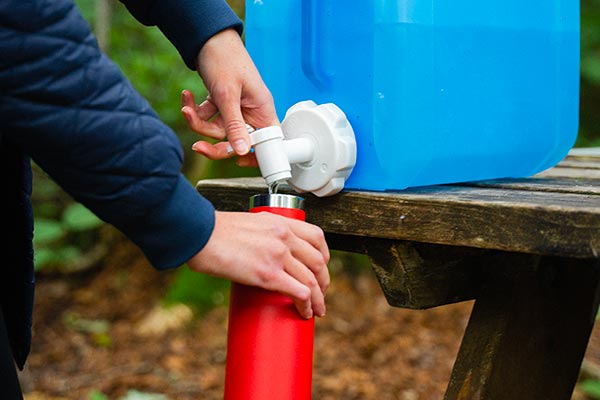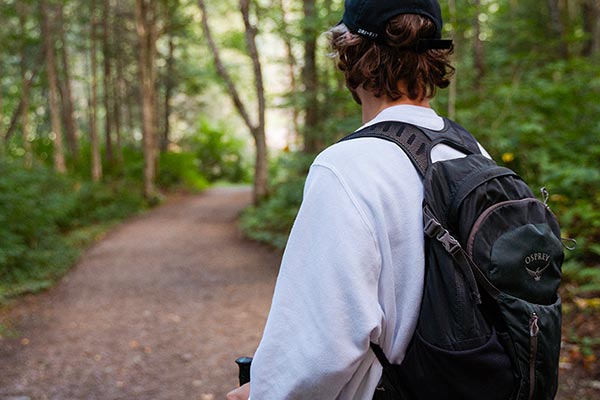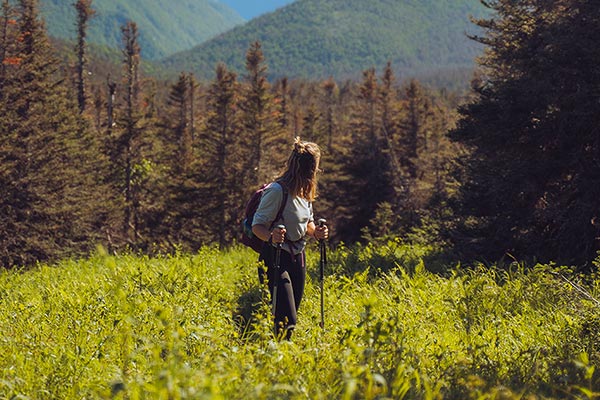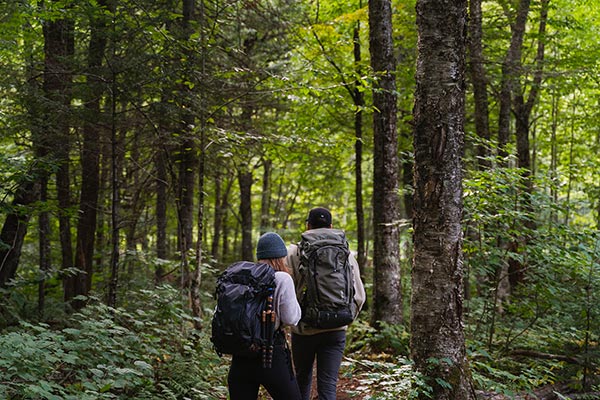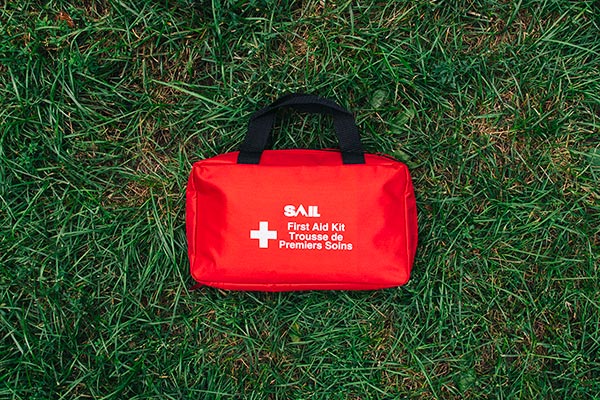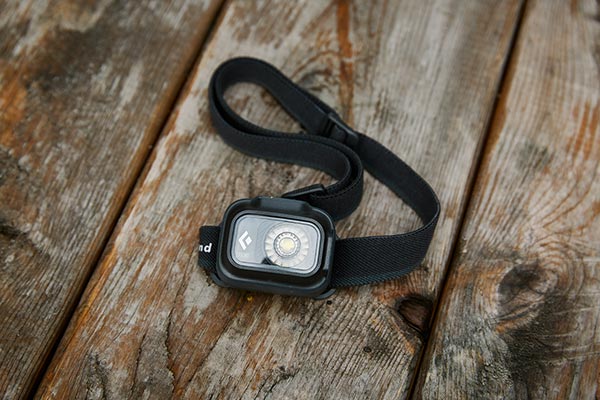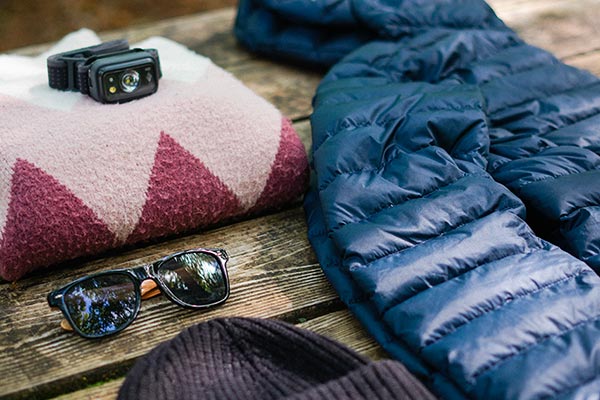The best backpack for a short hike
Four-fold expert advice
It's an inseparable partner for your adventures on the trail. In all shapes, colours, and sizes, a backpack remains every hiker’s essential accessory. But with so many choices on the market, how do you find your way around? Four pros come to the rescue to help you figure out what to buy.
 Auberge de montagne des Chic-Chocs
Auberge de montagne des Chic-Chocs
he right backpack for your needs
From the outset, professional adventurer François-Xavier (F.-X.) Bleau makes a statement about backpacks. "It's crazy how specialized the world of backpacks has become," exclaims the dude who works as logistics manager and guide for the prestigious Karavaniers agency. In fact, nowadays, there’s a packsack adapted to each activity or type of outing.
Due to his job, F.-X. has acquired a wide range of backpacks: one for climbing, one for skiing, one for short hikes, another for long expeditions... What should we remember if we don't want to end up with a vast collection of sacks? We have to keep in mind the importance of choosing a model according to how we’re likely to use it and that reflects our own personal needs.
For example, even if it looks good in the store, a backpack designed to withstand the rigours of climbing will usually be heavier and less comfortable than a model designed for hiking. The same goes for a ski bag, with all its specialized straps. Although it may be possible to get by with a sack made for another activity, a model adapted to our needs is always preferable, contends F.-X. the adventure guide.
The volume challenge
If there's one question that always comes up, it's the ideal size of backpack for day hiking. On this weighty question, our experts agree to disagree. However, there is a logic that should lead to an informed choice.
Teacher and coordinator of the Attestation of Collegial Studies (ACS) in Adventure Tourism at Cégep de Saint-Laurent, Renée-Claude Bastien admits that "this is a tricky little question.” For her professional use, she usually aims for a volume of about 35 litres. The same goes for François-Xavier, who prefers daypacks of 30 to 40 litres.
However, for the average person, Renée-Claude suggests a packsack of 20 to 25 litres, which should be able to hold all the necessary items. "Otherwise, the temptation to overload is always there," explains the sportswoman, reached by phone between a contract in the West and a stay in the Groulx Mountains with ladies from the Les Chèvres de montagne, an outdoor community for women.
The challenge of reducing our loads is easier to resolve than it used to be. "With advances in technology, everything is smaller," specifies Renée-Claude. If our accessories and warm clothes are compact and light, a smaller backpack can do the trick, even in the fall.
Accustomed to taking the essentials with her without being overloaded, Alexiane Huard has even made a 15-litre backpack her ideal sack for short trail outings. But the bubbly hiker, who has hiked the entire Québec portion (650 km) of the International Appalachian Trail (IAT), doesn't consider herself a minimalist. "With fifteen litres, I’m good to go," she affirms.
Obviously, during the cold season, the format is on the small side, she admits. If necessary, Alexiane, who has been a hiking enthusiast since 2015, simply hangs a coat or an accessory on the outside of her pack. "But most of the time, everything fits!” And on a long hike? These days she uses a 38-litre backpack.
Hiking light is a matter of experience and organization, especially because you also have to choose the right accessories and other essentials to bring along. In this regard, let’s check in with Alexis Nantel, who usually goes on an adventure with a small 18-litre pack. "If I'm with the kids or it’s winter, the volume will change accordingly," says the host of the Alexis le randonneur show.
“And for people who want a single backpack that can be adapted to various situations, a 30-litre size would do the trick," professes the dude who is also known for his role as outdoor columnist on Salut Bonjour.
Spending a lot... or a little?
Here again, it’s easy to lose one’s way. In the store, the walls are plastered with models and, even after an initial sorting to focus on hiking backpacks of the desired volume, the choice remains vast. Is paying more for an established brand worth the price? And how much should we pay?
Our experts agree that beyond the brand and the budget, comfort is what counts. Alexis, who advocates access to outdoor activities for as many people as possible, believes that a simple and affordable packsack can do the job very well for short trips. He especially recommends looking at the quality of construction: the seams, the materials used, and the strength of the straps and the other attachments. Alexiane agrees, noting that a higher price does not always mean a better backpack.
Renée-Claude uses this adage to illustrate her philosophy as a consumer of outdoor equipment: "I buy as if I were rich and I take care of my purchase as if I were poor!” Because for a minimum of quality and durability, you have to pay the price.
If you’re on a tight budget, the guide and teacher suggests that you consider buying used in order to afford a quality sack or watch for sales and clearance items. As for the price, it varies greatly, but let's just say that backpacks between $75 and $200 should meet the expectations and desires of almost all day hikers.
A thousand and one compartments
Are you a pocket lover or a pocket hater? That's what needs to be determined before deciding on a backpack. Some people can't live without their gear stored in various places, while others like the simplicity of a sack without compartments.
For reasons of weight, sturdiness (less risk of zipper breakage), and organization, most of our experts prefer a backpack with as few divisions as possible. While Alexiane "really loves pockets," not everyone shares her view. “Pockets get on my nerves!" laughs François-Xavier. “I suffer from the ‘where did I put my stuff’ syndrome!”
Although serial pockets serve to confuse the Val-David guide, he does appreciate a side or bottom opening backpack for easy access to its contents. This detail may even make the packsack more comfortable and secure. In fact, F. X. contends that multiple openings allow for better management of layers of clothing. If opening a bag is too complicated, people delay changing their clothes or taking a break, a "laziness" that can have consequences as the day progresses.
For his part, to stay organized, "Alexis the hiker" favors separating his equipment in small sacks. The best of both worlds! Because all this helps him to minimize the weight of his backpack. "More pockets means more zippers, and that means more weight. And in hiking, the heavier you are, the slower you go," affirms Renée-Claude.
A backpack wetback
Rain inevitably ends up inviting itself on a hike, but managing its effects is actually quite simple. A waterproof sack cover is a very practical accessory, according to our pros. “It’s saved my bacon many times," recounts Alexiane. “For me, hiking without a waterproof backpack is not a compromise I want to make.”
François-Xavier adds that despite the rain resistance of high quality backpacks, the good old rain cover is still very handy. He suggests choosing one that’s a little larger than the backpack for ease of use and opting for a bright colour, a question of safety when the weather goes downhill.
"The sack cover is a consideration, but you have to determine what type of hiker you are," contends Renée-Claude. In her view, if you go to a national park for an hour or two, it's no big deal if your backpack gets wet. "A garbage bag inside your pack can do the job," she points out.
Hydrating on a short hike
Although almost every backpack on the market has space for a tubed hydration pack (water bladder backpack), this feature is dispensable according to our expert quartet.
It’s true that a tubed packsack places water in an easy-to-reach place, close to the body, and encourages sporting types to drink more in all situations. However, as Renée-Claude points out, such a system makes it difficult to track consumption throughout the day. "It's important to be aware of what you're drinking so you don't run out at the wrong time," she stresses.
For the guide, it’s easier to keep track with bottles. They’re also simpler and faster to fill in the heat of the moment; they clean up better and don't freeze up like the tubes once winter arrives. That said, Renée-Claude doesn’t hesitate to use both systems, separately or together, depending on the circumstances.
Alexiane sees another advantage to choosing a simple bottle. "I'm more of a contemplative person. And for me, stopping for a moment to take a sip becomes fun. You enjoy the scenery," she states.
A matter of adjustment
"If you're not comfortable, there's no fun in hiking," asserts Alexiane, whose infectious good humour on the trail has earned her the nickname Sunshine. And when it comes to backpacks, comfort means getting the right fit. First of all, you have to choose a size adapted to your build: length of the back panel, type of shoulder straps, position of the hip belt... so many details to watch for to maximize comfort.
Depending on your body type, look at the models offered in the different sections of the stores. Do you need straps that allow for more chest clearance? What size sack fits your back? Always make sure that the backpack’s hip belt fastens snugly on your hips. Renée-Claude admits that this is particularly relevant for smaller people.
Ventilated back or not? A matter of preference, says François-Xavier. "It's good in the summer," he specifies. However, he warns us against certain models whose arched meshed frame encroaches on the loading space, in addition to moving the backpack's centre of gravity.
"You have to go and try them on for size," concludes Alexis, insisting on making the trial as true to life as possible. With 10 or 20 pounds added to the backpack, small discomforts will quickly become more obvious. "Ask for sandbags in the store," says the outdoor columnist. “Otherwise, you can test with your own accessories. In short, don't hesitate to investigate!”
Heading into the realm of nature with a light step and a happy back, you’ll certainly thank yourself for taking the time to choose your trail partner so carefully.
Our experts’ essential checklists
François-Xavier Bleau, professional guide at Karavaniers
Instagram: @fx_bleau
- First aid kit, including a flexible SAM Splint (perfect for sprains and the like)
- Opinel pocket knife (useful for emergencies... and to cut sausage!)
- Sunglasses with hard case
- Sunscreen
- Fork (F.-X. often forgets his utensils, so he always leaves a fork in his pack)
When accompanying a group, he includes
- A tarpaulin
- A warm layer depending on the season and circumstances (insulated clothing, sleeping bag, etc.)
- A means of communication adapted to the activity and the region visited (satellite phone and/or two-way radios)
Renée-Claude Bastien, teacher and coordinator of the Adventure Tourism Guide program at Cégep de Saint-Laurent
Instagram: @renee_claude_bastien_guide
- First aid kit with the essentials (mainly to treat blisters, cuts, and scrapes)
- Waterproof windbreaker
- Means of communication appropriate to the place visited
- Map of the trail
In the fall, Renee-Claude adds
- A headlamp (to avoid being surprised by the darkness that sets in earlier)
- Warmer clothing
To be well prepared, she suggests consulting the fact sheets in the Rando Québec hiker's kit (in French only).
Alexiane Huard, hiking enthusiast who completed the 650 km of the Québec portion of the International Appalachian Trail (IAT) between 2019 and 2021
Instagram: @alexiane.sunshine
- First aid kit ("Mine is tiny, but it can be a life saver!" asserts the long-distance hiker.)
- Snacks (fruit, cookies, mashed potatoes... whatever fuel turns you on. "Sweetness is good for you," exclaims the lady who loves to devour Oreos at the top of the trail. )
- Water
- Windbreaker ("I never leave home without my raincoat!" confides the sportswoman)
Alexis Nantel, host of the Alexis le randonneur program and outdoor columnist on Salut Bonjour
Instagram: @alexislerandonneur
- Compact water filter (allows you to carry less water and refill your bottle as needed at one of the sources identified on the map before leaving)
- Lighter, whistle, and knife (true to the philosophy of the adventurer Frederic Dion, he never leaves without these three essential tools to signal his presence and light a fire)
- First aid kit
- Clothing appropriate to the location and season
- Headlamp (especially in the fall)
